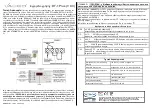
Circuit Description
132
CTC100 Programmable Temperature Controller
B ackplane
The backplane uses a proprietary parallel bus to connect the CPU card to the six I/O cards and
the front panel. The bus has six I/O card slots. All six slots are equivalent; only the chassis cutouts
constrain which cards are plugged into which slots.
The backplane also in5V and +3.3V switching power supplies for the CTC100
components, and +10, +20, and -20V switching supplies for the low-noise analog circuitry.
Jumper J203 connects the analog supply ground to the system ground; if removed, the analog
supplies operate with a floating ground.
A circuit is available (U201, U202) to synchronize the switching frequency of the various
switching supplies with each other, potentially reducing noise. The circuit is normally not used
noticeable effect on noise levels.
An AC power bus (J100 J104) distributes 120 or 220VAC power to any CTC420 AC output
cards that are installed. The AC power connectors have a lifetime of 25 mate/unmate cycles.
Connected to the AC bus is a line trigger circuit that synchronizes the A/D sampling (actually
the CONV* signal; see the description of pin C18 below) with the 50 or 60 Hz line frequency. If
this circuit fails, the CTC100 may become unresponsive. Jumper J160 can be used to synchronize
the CONV* signal to a 1 MHz clock instead of the line frequency; in this case, the A/D sampling
period can be set to any integer multiple of 1 µs rather than being limited to an integer multiple of
the line period, but 60 Hz interference is inevitable. Jumper J160 should not be moved while the
CTC100 is turned on.
The pinout of the I/O card connectors on the backplane bus is described below. The pin
P ow er
A31 A32: 8V. An analog supply used to ge5V.
B31 B32: +20V. An analog supply used to ge15V.
C31 C32: -20V. An analog supply used to generate -15V.
A29 A30, B29 B30, C29 C30: AGND. Ground for the analog supplies. May be floating
relative to digital ground.
A27 A28: +3.3V. Powers the ColdFire CPU and other components on the CPU card.
B27 B28, B12 B22, A3, A12, A14, A18, B3, C3, C19: DGND. Ground for the +3.3V and
+5V supplies.
C27 C28: +5V. Powers the Atmel microcontrollers and all other digital components on the
I/O cards.
A25 A26, B25 B26, C25 C26: +24V. Connects directly to the CTC100
power supply. Used for all high-current outputs.
A23 A24, B23 B24, C23 C24: 24VR. Ground return for the +24V supply.
A1, A2, B1, B2, C1, C2: 24VGND. Ground for +24V.
P arallel bus
This proprietary 8-bit data bus is used for communication between the CPU card and I/O cards.
A4 A11: ADD[0:7]. The address lines. ADD0 ADD3 are used to select a specific card.
ADD4 ADD7 are not used.
A13. CLK (Clock). A 16 MHz clock signal used for the Atmel microcontrollers.
A15: RESET*. When pulled low, the Atmel microcontrollers on all I/O cards are reset,
regardless of whether or not CS* is active. Used to upload firmware onto the
microcontrollers.
B4 B11, C4 C11: D[0:15]. The data lines. Only D0 D7 are currently used.
Summary of Contents for CTC100
Page 1: ...Version 2 1 May 14 2019 User Manual CTC100 Cryogenic Temperature Controller...
Page 6: ......
Page 8: ......
Page 12: ......
Page 25: ...Operation 13 CTC100 Programmable Temperature Controller...
Page 85: ...Operation 73 CTC100 Programmable Temperature Controller To disable cascade cont select it...
Page 128: ......
Page 129: ...Remote Programming 117 CTC100 Programmable Temperature Controller...
Page 130: ......
Page 142: ......
Page 150: ......
Page 176: ......
















































